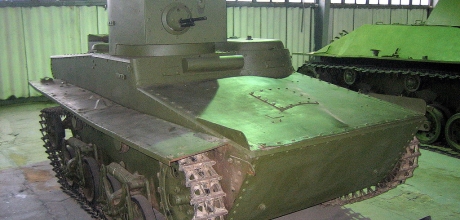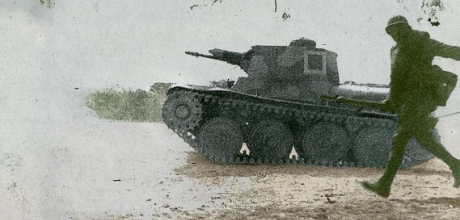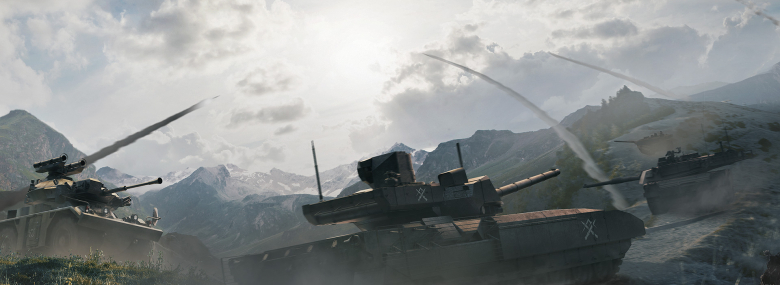
Commanders!
In the past, the T-64 was a tank available in Armored Warfare on lower Tiers. In Balance 2.0, it was replaced by the 1969 model of the T-64A – but to understand the T-64A, we first have to look at its predecessor.

T-64
When looking at the tanks from 1960s and 1970s, there can only be one correct conclusion drawn from the vehicles of the era – the Soviet tanks were completely superior to the NATO ones during those decades. This conclusion naturally disregards things such as crew training levels and morale but the Soviet war machines of that time were ahead of the NATO ones. The T-64 series is the ultimate embodiment of this superiority.
The Object 432 development (the project name of the T-64 before it was officially accepted in service) was based on the Object 430 project that had been terminated in 1961. The termination was a result of the Object 430 not being a significant enough improvement over the T-55 medium tank and, as such, the tank designers of the Malyshev Plant in Kharkov had to come up with something better. And they did.
The development of the Object 432 started in the May of 1961 in the KB-60 design bureau and the first actual prototype was ready in the September of 1962 (between March and September, various partial prototypes and mockups were tested as well).
The vehicle generally resembled the Object 430 visually but there was one very significant change – the Object 432 would be the first Soviet tank to use composite armor. The Soviets were well-aware of the HEAT shell potential – the problem was, the enemy had them too and the crews had to be protected against them. Additionally, there was the British L7 105mm rifled gun and the Soviets were well-aware of it. Simply put, the new tank’s protection levels had to be upgraded to meet these new threats.

Object 430
Despite these considerable challenges, the Kharkov engineers came out of the entire program with flying colors. What they designed was a relatively light, compact tank with state of the art armor.
The Object 432 weighed 35 tons and had a crew of three men – commander, gunner and driver. There was no loader because the gun was loaded automatically – but we’ll get to that, let’s first take a look at this vehicle’s protection levels.
As was mentioned above, the frontal armor (of both the hull and the turret) was composite – what that means is, it consisted of layers of different materials, combined to provide as much protection as possible while keeping the weight limited so that this tank (still classified as a medium tank, not a Main Battle Tank) wouldn’t become too heavy.
As was common back then on all Soviet tanks, the upper frontal plate was well-sloped (22 degrees angle from horizontal) and consisted of the following layers:
- 80mm of armor steel
- 105mm of textolite
- 20mm of armor steel
The front of the turret was composite as well, featuring an aluminum alloy inlay, roughly as such (frontal projections):
- 120mm of armor steel
- 300mm of aluminum alloy
- 190mm of armor
The alloy inlay and the steel armor were not distributed evenly – instead, most of it was concentrated to the front of the vehicle, resulting in excellent protection levels. According to the Soviet data, the vehicle was impervious to all types of NATO 105mm rifled gun shells frontally (specifically, 20 degrees to each side of the vehicle’s axis).
However, in order to keep the weight low, the rest of the tank wasn’t protected as well. Only the front had composite armor (specifically, the upper frontal plate and the turret) – the rest was armored as such:
- Hull lower frontal plate: 80mm of steel
- Hull sides: 80mm (56mm above roadwheels)
- Hull rear: 50mm
- Hull top: 16mm
- Hull bottom: 20mm
- Turret rear and rear sides: 65mm
- Turret roof: 45mm
Still, when you compare it to the tanks it would face back in 1964, it was a huge leap forward as the Centurions and the M48/M60 series were nowhere near protected enough to withstand its firepower as the Israelis learned the hard way during the Yom Kippur War.
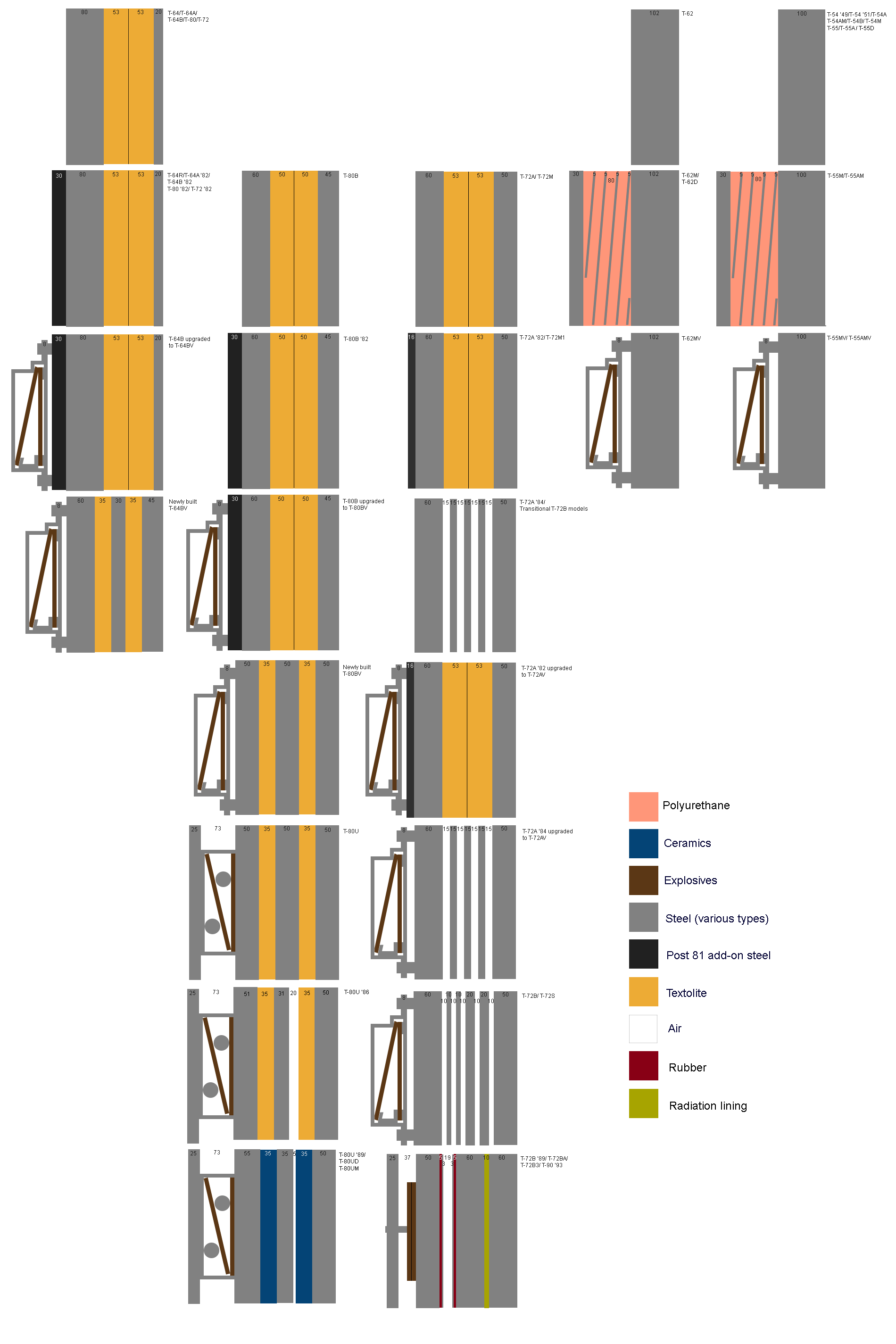
The T-62 used the same caliber gun (115mm smoothbore) as the Object 432 but the gun was actually different – the T-62 used a gun called 2A20 (or U-5TS Molot) while the Object 432 used another gun derived from it, called 2A21 (or D-68). If you are interested in the development of the 115mm caliber, please visit our dedicated article but the 2A20 was generally a very effective weapon, the shells of which would literally punch through Israeli tank turrets and exit on the other side.
The gun was fully stabilized using the 2E18 Siren stabilizer and the gunner aimed it with the TPD-43 gun sights and rangefinder system (TPN-1 sights for firing at night). Its maximum elevation was +14 degrees and its maximum depression was -6 degrees. Like we mentioned before, the gun was automatically loaded by an electric-hydraulic mechanism – another new feature at that time.
The main difference between the 2A20 and 2A21 guns was that the Object 432 gun used two-piece shells in order to make the automatic loading mechanism work.
Contrary to popular belief, the automatic loading of the T-64 series worked differently than on the T-72.
The rounds for the gun consisted of two parts (the shell itself and a charge) and there was a carousel below the turret where both components were stored. In a T-72, the charge is stored horizontally above the shell and the automatic mechanism rams first the shell and then the charge into the barrel. In a T-64, the charges are also stored above the shells, but vertically and the loading mechanism loads both components at the same time. It can be seen on the image below:
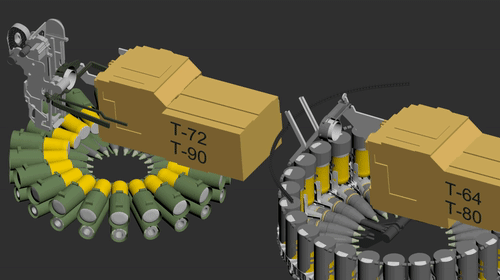
This solution was basically a reaction to the 115mm shell size and its rate of fire in the T-62 tank, which was 4 to 5 rounds per minute (much less when the tank was moving, the loader was not skilled etc.). This automatic system along with the shell split increased the gun’s rate of fire to 8 to 9 rounds per minute. The tank carried 40 rounds, 30 of which were pre-loaded in the automatic loader.
The following rounds were used on the T-64:
- 3VBM1 subcaliber round (penetrating 250mm of RHAe at 1000m at 0 degrees or 135mm at 60 degrees from vertical)
- 3VBK4 HEAT round (penetrating 450mm of RHAe at any distance for the modernized 3BK8M shell)
- 3VOF18 HE round
The subcaliber round could be fired accurately at 4000 meters, the other two round types at 3300 meters.
The Object 432 was powered by a rather interesting powerplant – the 5TDF 13.5 liter 5-cylinder opposite piston two-stroke engine producing 700 horsepower, paired with a mechanical planetary transmission with 5 forward gears and 1 reverse gear, allowing the tank to go as fast as 65 km/h (although the speeds of 30-40 km/h were more common).
The engine was extremely light and compact thanks to its unusual design (the entire engine weighed a little over a ton), but it was also relatively unreliable, difficult to start at winter and produced a lot of heat, making the tank very visible in the IR spectrum. It remained a signature vehicle feature for the Kharkov T-64 tank series – other Soviet tanks used more conventional engines.
The vehicle used an individual torsion bar suspension and can be recognized from the T-72 series at first glance by its typical small roadwheels. The really interesting part on it was the fact that the tank did not have the roadwheel off-set typical for torsion bar tank suspension designs – that was because the torsion bars were not covering the entire width of the vehicle – instead, they only reached the middle.

T-64
Additional protective measures included:
- NBC protection system
- Automatic fire extinguisher
- Smoke generator (by injecting fuel into the exhaust system)
As you can see from the number of innovative features, the tank was indeed very advanced and therefore very expensive.
Three prototypes in total were built until the December of 1962 and were thoroughly tested until the March of 1963. The trials went well and the Malyshev plant received an order to get ready for mass production of this tank. The first mass-produced vehicles were built between the November of 1963 and the July of 1964 and the tank was officially accepted in service on the 30th of December, 1966 under the designation of T-64.
When it comes to its production, finding the actual correct number is very problematic as various sources claim various things. The production likely ran from late 1963 to late 1967 or 1968. The actual number of vehicles produced also varies (sources range from approximately 1200 to as many as 2000 tanks).
Throughout the production, the tank was constantly modernized and its teething problems and flaws were fixed – in 1965, it received, for example, the typical Soviet anti-HEAT “side shields” that were extended in combat, although few units bothered to do so during training (the shields tended to get stuck on things, they got damaged etc.), which is why so few images of the tanks with shields extended exist. These shields were to protect the suspension of the vehicle.
The T-64 never participated in combat apart from some large-scale exercises such as the 1973 Dnepr and was never exported.

T-64
Between 1977 and 1980, a portion of these vehicles underwent an overhaul to bring them to the T-64A standard (post-1965 production vehicles) with the exception of the gun, although some sources dispute that. These overhauled T-64s are referred to as Object 432R (or T-64R). The older machines were phased out and scrapped. The T-64R remained in service until after the breakup of the Soviet Union when most of them likely ended up in Ukraine. How many of these tanks remain is unknown.
The importance of this vehicle for the Soviet war machine cannot, however, be overestimated. For all its drawbacks, it was, at the time of its introduction, a cutting edge design and a relatively low number of them were produced only because it was very expensive and intended for core unit use only – the NATO units in Germany would face these tanks in case of an invasion (in any direction), replacing the heavy tanks of old in the Soviet elite units.
Next time, we’ll take a look at its better known successor, the T-64A.
See you on the battlefield!




